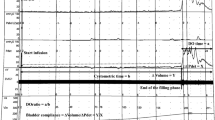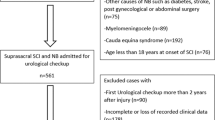Abstract
Objectives:
To evaluate whether the ice water test (IWT) should be performed before or after the standard urodynamic investigation (UDI).
Patients and methods:
Two cohorts of patients suffering from neurogenic lower urinary tract dysfunction (NLUTD) due to spinal cord injury (SCI) were matched by lesion level and age. The patients of cohort A (n=55, retrospective cohort) underwent the IWT before and the patients of cohort B (n=110, prospective cohort) after standard UDI. The IWT effect on urodynamic parameters has been compared between the two groups using the Mann–Whitney U-test for independent samples. UDI was performed according to good urodynamic practices recommended by the International Continence Society.
Results:
The mean age of both cohorts was 49 years. Performing the IWT before versus after standard UDI resulted in a significantly lower maximum cystometric bladder capacity (P=0.01), lower incidence of detrusor overactivity (P=0.017) and lower maximum detrusor pressure during IWT (P=0.04). All other urodynamic parameters assessed demonstrated no significant difference (P>0.05).
Conclusions:
Our results are in line with findings from animal studies demonstrating a bladder cooling-induced gating effect on the micturition reflex volume threshold on the level of sacral interneurons. Since the IWT is an unphysiological investigation that might significantly bias subsequent urodynamics, we suggest that the IWT should not precede more physiological standard UDI.
Similar content being viewed by others
Log in or create a free account to read this content
Gain free access to this article, as well as selected content from this journal and more on nature.com
or
References
Bors EH, Blinn KA . Spinal reflex activity from the vesical mucosa in paraplegic patients. AMA Arch Neurol Psychiatry 1957; 78: 339–354.
Raz S . Objective assessment of bladder response in ice water test. J Urol 1973; 109: 603–604.
Fall M, Lindstrom S, Mazieres L . A bladder-to-bladder cooling reflex in the cat. J Physiol 1990; 427: 281–300.
Mazieres L, Jiang C, Lindstrom S . The C fibre reflex of the cat urinary bladder. J Physiol 1998; 513: 531–541.
Geirsson G, Lindstrom S, Fall M . The bladder cooling reflex and the use of cooling as stimulus to the lower urinary tract. J Urol 1999; 162: 1890–1896.
Mukerji G, Waters J, Chessell IP, Bountra C, Agarwal SK, Anand P . Pain during ice water test distinguishes clinical bladder hypersensitivity from overactivity disorders. BMC Urol 2006; 6: 31.
Mukerji G, Yiangou Y, Corcoran SL, Selmer IS, Smith GD, Benham CD et al. Cool and menthol receptor TRPM8 in human urinary bladder disorders and clinical correlations. BMC Urol 2006; 6: 6.
Wyndaele JJ, De Wachter S . The sensory bladder (1): an update on the different sensations described in the lower urinary tract and the physiological mechanisms behind them. Neurourol Urodyn 2008; 27: 274–278.
Yoshimura N, Chancellor MB . Current and future pharmacological treatment for overactive bladder. J Urol 2002; 168: 1897–1913.
Geirsson G, Lindstrom S, Fall M . Pressure, volume and infusion speed criteria for the ice-water test. Br J Urol 1994; 73: 498–503.
Abrams P, Cardozo L, Fall M, Griffiths D, Rosier P, Ulmsten U et al. The standardisation of terminology of lower urinary tract function: report from the Standardisation Sub-committee of the International Continence Society. Neurourol Urodyn 2002; 21: 167–178.
Schafer W, Abrams P, Liao L, Mattiasson A, Pesce F, Spangberg A et al. Good urodynamic practices: uroflowmetry, filling cystometry, and pressure-flow studies. Neurourol Urodyn 2002; 21: 261–274.
Sekhon JS . Multivariate and Propensity Score Matching Software with Automated Balance Optimization: the Matching Package for R. J Stat Softw 2011; 42: 1–52.
Jiang CH, Mazieres L, Lindstrom S . Cold- and menthol-sensitive C afferents of cat urinary bladder. J Physiol 2002; 543: 211–220.
Jiang CH, Mazieres L, Lindstrom S . Gating of the micturition reflex by tonic activation of bladder cold receptors in the cat. Neurourol Urodyn 2009; 28: 555–560.
De Groat WC, Ryall RW . Recurrent inhibition in sacral parasympathetic pathways to the bladder. J Physiol 1968; 196: 579–591.
Morgan CW . Axons of sacral preganglionic neurons in the cat: II. Axon collaterals. J Neurocytol 2001; 30: 767–787.
de Groat WC . Mechanisms underlying recurrent inhibition in the sacral parasympathetic outflow to the urinary bladder. J Physiol 1976; 257: 503–513.
Michels L, Blok BF, Gregorini F, Kurz M, Schurch B, Kessler TM et al. Supraspinal Control of Urine Storage and Micturition in Men-An fMRI Study. Cereb Cortex, e-pub ahead of print.
van Meel TD, de Wachter S, Wyndaele JJ . Repeated ice water tests and electrical perception threshold determination to detect a neurologic cause of detrusor overactivity. Urology 2007; 70: 772–776.
Bellucci CH, Wöllner J, Gregorini F, Birnböck D, Kozomara M, Mehnert U et al. Neurogenic lower urinary tract dysfunction—do we need same session repeat urodynamic investigations? J Urol 2012; 187: 1318–1323.
de Groat WC, Yoshimura N . Afferent nerve regulation of bladder function in health and disease. Handb Exp Pharmacol 2009; 194: 91–138.
de Groat WC, Yoshimura N . Changes in afferent activity after spinal cord injury. Neurourol Urodyn 2010; 29: 63–76.
Fowler CJ, Griffiths D, de Groat WC . The neural control of micturition. Nat Rev Neurosci 2008; 9: 453–466.
Yoshimura N, Erdman SL, Snider MW, de Groat WC . Effects of spinal cord injury on neurofilament immunoreactivity and capsaicin sensitivity in rat dorsal root ganglion neurons innervating the urinary bladder. Neuroscience 1998; 83: 633–643.
Juszczak K, Thor PJ . The basic neurophysiologic concept of lower urinary tract function—the role of vanilloid TRPV1 receptors of urinary bladder afferent nerve endings. Adv Clin Exp Med 2012; 21: 417–421.
Ismael SS, Epstein T, Bayle B, Denys P, Amarenco G . Bladder cooling reflex in patients with multiple sclerosis. J Urol 2000; 164: 1280–1284.
Al-Hayek S, Abrams P . The 50-year history of the ice water test in urology. J Urol 2010; 183: 1686–1692.
Acknowledgements
This study was funded by the Swiss Continence Foundation (www.swisscontinencefoundation.ch) and the Clinical Research Priority Program NeuroRehab of the University of Zürich. The Swiss Continence Foundation and the Clinical Research Priority Program NeuroRehab of the University of Zürich had no role in study design, data collection and analysis, decision to publish or preparation of the manuscript.
Author information
Authors and Affiliations
Corresponding author
Ethics declarations
Competing interests
The authors declare no conflict of interest.
Rights and permissions
About this article
Cite this article
Kozomara, M., Bellucci, C., Seifert, B. et al. Urodynamic investigations in patients with spinal cord injury: should the ice water test follow or precede the standard filling cystometry?. Spinal Cord 53, 800–802 (2015). https://doi.org/10.1038/sc.2015.152
Received:
Revised:
Accepted:
Published:
Issue date:
DOI: https://doi.org/10.1038/sc.2015.152
This article is cited by
-
Use of the ice water test as an early predictor of recovery of erectile function in patients with spinal cord injury
Spinal Cord Series and Cases (2020)



